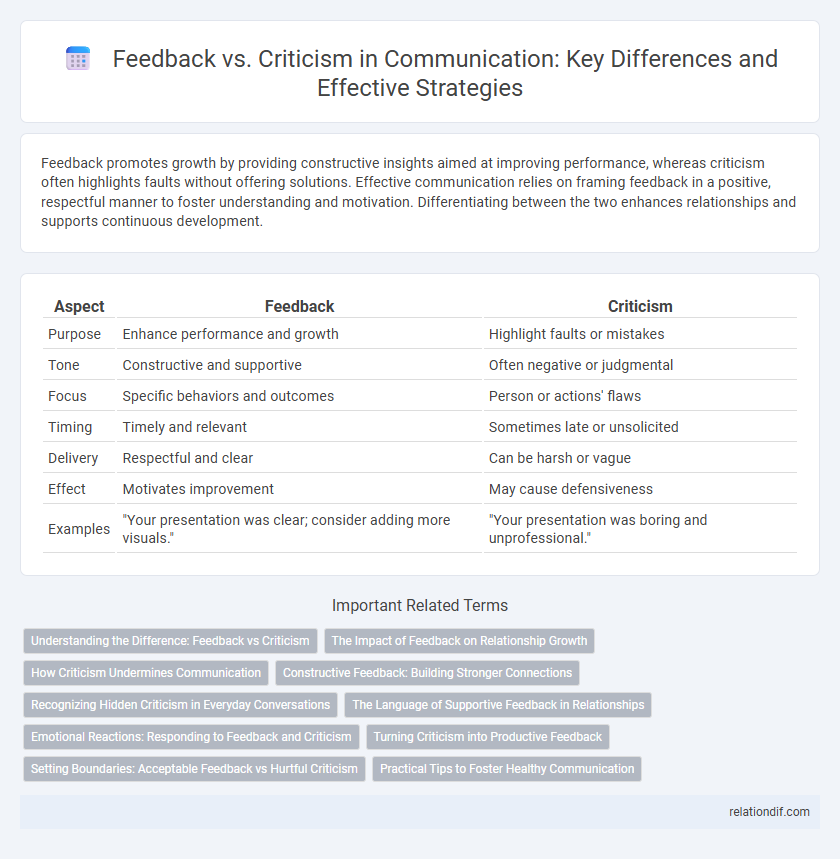Feedback promotes growth by providing constructive insights aimed at improving performance, whereas criticism often highlights faults without offering solutions. Effective communication relies on framing feedback in a positive, respectful manner to foster understanding and motivation. Differentiating between the two enhances relationships and supports continuous development.
Table of Comparison
| Aspect | Feedback | Criticism |
|---|---|---|
| Purpose | Enhance performance and growth | Highlight faults or mistakes |
| Tone | Constructive and supportive | Often negative or judgmental |
| Focus | Specific behaviors and outcomes | Person or actions' flaws |
| Timing | Timely and relevant | Sometimes late or unsolicited |
| Delivery | Respectful and clear | Can be harsh or vague |
| Effect | Motivates improvement | May cause defensiveness |
| Examples | "Your presentation was clear; consider adding more visuals." | "Your presentation was boring and unprofessional." |
Understanding the Difference: Feedback vs Criticism
Feedback involves constructive, specific guidance aimed at improvement and growth, while criticism often highlights faults without offering solutions, potentially leading to defensiveness. Understanding the difference between feedback and criticism is crucial for effective communication, as feedback fosters a positive, solution-oriented dialogue. This distinction promotes learning, motivation, and stronger relationships in personal and professional environments.
The Impact of Feedback on Relationship Growth
Constructive feedback fosters trust and strengthens communication by emphasizing growth and understanding, whereas criticism often triggers defensiveness and damages rapport. Effective feedback promotes a positive dialogue that encourages mutual respect and continuous improvement, essential for relationship development. Emphasizing specific behaviors and offering actionable suggestions enhances collaboration and deepens interpersonal connections.
How Criticism Undermines Communication
Criticism often undermines communication by creating defensiveness and eroding trust between parties. Unlike constructive feedback that encourages growth, criticism tends to focus on faults, triggering negative emotions and reducing openness. This breakdown in dialogue hampers effective problem-solving and collaboration, leading to misunderstandings and conflict.
Constructive Feedback: Building Stronger Connections
Constructive feedback fosters stronger connections by focusing on specific behaviors and offering practical suggestions for improvement, promoting growth and mutual respect. Unlike criticism, which often highlights faults without solutions, constructive feedback encourages open dialogue and collaboration within teams. Effective communication through constructive feedback enhances trust, motivation, and overall team performance.
Recognizing Hidden Criticism in Everyday Conversations
Hidden criticism often appears in everyday conversations disguised as backhanded compliments or subtle sarcasm, making it difficult to recognize without careful attention. Identifying such feedback requires tuning into tone, body language, and context clues that reveal underlying negative judgments. Effective communication involves distinguishing constructive feedback aimed at improvement from covert criticism that may harm relationships or morale.
The Language of Supportive Feedback in Relationships
Supportive feedback in relationships uses empathetic and constructive language to foster understanding and growth, emphasizing specific behaviors rather than personal attributes. Phrases like "I feel" and "I noticed" encourage openness and reduce defensiveness, promoting emotional safety. This approach strengthens trust and collaboration, enabling partners to address issues positively without damaging self-esteem.
Emotional Reactions: Responding to Feedback and Criticism
Emotional reactions to feedback and criticism often differ; feedback tends to be perceived as constructive guidance, fostering growth and positive change, while criticism can trigger defensiveness or discouragement due to its negative tone. Understanding these emotional responses is crucial for effective communication, enabling individuals to manage feelings and respond thoughtfully rather than react impulsively. Developing emotional intelligence helps transform criticism into actionable insights, promoting resilience and improved interpersonal dynamics.
Turning Criticism into Productive Feedback
Transforming criticism into productive feedback involves focusing on specific behaviors rather than personal traits, allowing constructive dialogue that fosters improvement. Using clear, actionable language helps recipients understand the issue and encourages positive change, enhancing communication effectiveness in professional and personal settings. Emphasizing empathy and solution-oriented suggestions shifts the dynamic from judgment to growth, ultimately strengthening relationships and performance.
Setting Boundaries: Acceptable Feedback vs Hurtful Criticism
Setting clear boundaries between acceptable feedback and hurtful criticism is essential for maintaining healthy communication. Acceptable feedback focuses on specific behaviors or outcomes, aiming to foster growth and understanding without attacking a person's character. Hurtful criticism often involves personal attacks or vague judgments that can damage self-esteem and erode trust in relationships.
Practical Tips to Foster Healthy Communication
Providing clear, specific feedback focused on behavior rather than personal traits fosters constructive dialogue and mutual understanding. Using "I" statements and active listening techniques helps reduce defensiveness and encourages openness during conversations. Establishing regular feedback routines and maintaining a respectful tone creates a safe environment for continuous improvement and healthy communication dynamics.
Feedback vs Criticism Infographic

 relationdif.com
relationdif.com